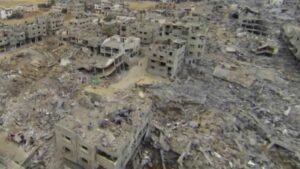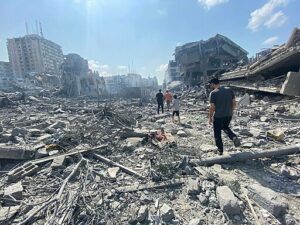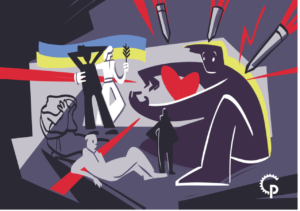Gaza: A Ghastly Window into the Crisis of
Global Capitalism
 As the world watches in horror over the mounting death toll of Palestinian civilians and Israel faces charges before the International Court of Justice for the Crime of Genocide, the carnage in Gaza gives us a ghastly window into the rapidly escalating crisis of global capitalism. Connecting the dots from the merciless Israeli destruction of Gaza to this global crisis requires that we step back to bring into focus the big picture. Global capitalism faces a structural crisis of overaccumulation and chronic stagnation. But the ruling groups also face a political crisis of state legitimacy, capitalist hegemony, and widespread social disintegration, an international crisis of geopolitical confrontation, and an ecological crisis of epochal proportions.
As the world watches in horror over the mounting death toll of Palestinian civilians and Israel faces charges before the International Court of Justice for the Crime of Genocide, the carnage in Gaza gives us a ghastly window into the rapidly escalating crisis of global capitalism. Connecting the dots from the merciless Israeli destruction of Gaza to this global crisis requires that we step back to bring into focus the big picture. Global capitalism faces a structural crisis of overaccumulation and chronic stagnation. But the ruling groups also face a political crisis of state legitimacy, capitalist hegemony, and widespread social disintegration, an international crisis of geopolitical confrontation, and an ecological crisis of epochal proportions.
Global corporate and political elites are in a drunkard’s hangover from the world capitalist boom of the late twentieth and early twenty-first centuries. They have had to acknowledge that the crisis is out of control. In its 2023 Global Risk Report, the World Economic Forum warned that the world confronts a “polycrisis” involving escalating economic, political, social, and climactic impacts that “are converging to shape a unique, uncertain and turbulent decade to come.” The Davos elite may be clueless as to how to resolve the crisis but other factions of the ruling groups are experimenting with how to mold interminable political chaos and financial instability into a new and more deadly phase of global capitalism.
While the military outcome of the Gaza war has yet to be determined, there is no doubt that Israel and its enablers in the core states of world capitalist system are losing the political war for legitimacy. The initial months of siege on Gaza appeared to crystallize a Washington-NATO-Tel Aviv axis prepared to normalize genocide even at great political cost. Yet the Palestinian plight has touched a raw nerve among mass publics around the world, especially among youth, giving new energy to the global revolt of the working and popular classes that has been gaining momentum in recent years and heightening the political contradictions of the crisis. In the United States, from where we pen these lines, there has been an extraordinary outpouring of solidarity with Palestine led by a younger generation of Jews who do not identify with Zionism and the Jewish state. The Palestinian flag, raised around the world in street demonstrations, sporting events, and social media platforms, has become a symbol of popular rage and global intifada against the prevailing status quo.
The twentieth century saw at least five cases of acknowledged genocide, defined by the United Nations Convention as a crime committed with the intent to destroy a national, ethnic, racial or religious group, in whole or in part. The century started with the genocide of the Herero and Nama by German colonialists from 1904 to 1908 in what is today Namibia. This was followed by the Ottoman genocide of Armenians in 1915 and 1916, the Nazi holocaust of 1939-1945, and the Rwandan genocide of 1994. As Israeli genocide in Gaza is livestreamed the rules of warfare no longer apply, if they ever did, for Tel Aviv and Washington. There were more civilian deaths recorded in Gaza in the first two months of the conflict, nearly 20,000, than in the first 20 months of the Russia-Ukraine conflict, which took 9,614 civilian lives. Whether the Israeli siege consummates genocide in the first twenty-first century may be determined less on the military than on the global political battlefield. Israel may be a testing ground for the ruling groups from the Washington-NATO-Tel Aviv axis to see just how far they can enjoy impunity before the costs of Israel’s siege become too high.
Surplus Capital, Surplus Labor, Genocide
The crisis of world capitalism in the 1930s paved the way for the rise of fascism in Europe, the violent breakdown of the international political and economic order, and a second world war that brought devastation previously unimaginable. The Great Depression had been preceded by an age of giddy capitalist excess amidst inequalities and rising mass discontent, the so-called gilded age that saw unrestrained capital rush headlong into the such a crisis of overaccumulation that it all came crashing down in 1929. The 2008 global financial collapse marked the onset of a new crisis of overaccumulation and chronic stagnation.
The political economy of genocide in our time is marked by this crisis. The problem of surplus capital is endemic to capitalism but over the past couple of decades it has reached extraordinary levels. The leading transnational corporations and financial conglomerates have reporded record profits at the same time that corporate investment has declined. The transnational capitalist class has accumulated obscene amounts of wealth, well beyond what it can reinvest. The extreme concentration of the planet’s wealth in the hands of the few and the accelerated impoverishment and dispossession of the majority has made it increasing difficult for this TCC to find new outlets to unload enormous amounts of accumulated surplus. Transnational capitalists and their agents in states have relied on debt-driven growth, wild financial speculation, the plunder of public finance, and state-organized militarized accumulation to sustain the global economy in the face of chronic stagnation. As outlets to unload surplus accumulated capital dry up new outlets must be violently created.
The Israeli political economy is emblematic. The siege of Gaza and the West Bank is a form of primitive accumulation aimed at cracking open new space for transnational accumulation. In late October, as Israeli bombardment intensified, Israel set about granting licenses to transnational energy companies for gas and oil exploration off the Mediterranean coast, part of its plan to become a major regional gas producer and energy hub as well as an alternative to Russian gas for Western Europe. One Israeli real estate company notorious for building settlements in occupied Palestinian territories published an advertisement in December for the construction of luxury homes in bombed out Gaza neighborhoods, while others spoke of resuscitating the Ben Gurion Canal Project that has been dormant since it was originally proposed in the 1960s. The project involves building an alternative to the Egyptian-run Suez Canal that would run from the Gulf of Aqaba across the Negev desert and Gaza out to the Mediterranean. The only thing stopping the newly-revised Canal project is the presence of Palestinians in Gaza.
But two things had to happen before genocide could become an option. First, the role of Palestinian labor in the Israeli economy had to be resolved. The 1948 Nakba that established the Jewish state involved the violent expulsion of the Palestinians and the expropriation of their land but also the subordinate incorporation of hundreds of thousands of Palestinian laborers to work on Israeli farms, construction sites, industries, caregiving and other service jobs and the conversion of the West Bank into a captive market for Israeli capitalists. This marked a tension between the drive to ethnically cleans the Jewish state and the need it had for cheap, ethnically demarcated labor. Starting in the 1990s Israel began to resolve this tension between dispossession/super-exploitation and dispossession/expulsion in favor of the latter. Transnational labor mobility and recruitment have made it possible for capitalists around the world, including from Israel, to reorganize labor markets and to recruit transient labor forces that are disenfranchised and easy to control. In this way, Israel has been gradually replacing the Palestinian labor force with migrant labor.
Israel imposed its “closure” policy in 1993, in the wake of the first intifada, that is, sealing off Palestinians in occupied territories, ethnic cleansing, and a sharp escalation of settler colonialism. Hundreds of thousands of migrant workers from Thailand, China, Sri Lanka, India, the Philippines, North Africa, Eastern Europe and elsewhere now labor in the Israeli economy (at least 30 Thai nationals, four Filipinos and 10 Nepalis were killed in the Hamas attack and a number of others taken hostage). They do not need to be subjected to the apartheid system imposed on Palestinians because their temporary migrant status achieves their social control and disenfranchisement more effectively, and of course because they are not demanding the return of occupied lands and do not have a political claim to a state. In the wake of the October 7 Hamas attack Israel deported thousands of Palestinian workers back to Gaza while some 10,000 foreign agricultural workers fled the country Israeli construction companies asked the government to allow them to hire 100,000 Indian workers to replace Palestinians.
The Palestinian masses have gone from serving as a tightly-controlled and super-exploited labor force for Israeli and transnational capital to surplus humanity standing in the way of a new round of capitalist expansion. Gaza thus becomes a potent symbol of the plight of surplus humanity around the world. Decades of globalization and neoliberalism have relegated great masses of people to marginal existence. New technologies based on artificial intelligence combined with displacement generated by conflict, economic collapse, and climate change will exponentially increase the ranks of surplus humanity. The ILO reported as far back as the turn of century that some one-third of the global labor forces had been made superfluous. A 2020 study by the U.S. National Academy of Sciences predicted that for every additional one-degree centigrade rise in the average global climate a billion people will be forced to abandon their locations and to endure insufferable heat.
Israel brings home the tension worldwide between the economic need ruling groups have for super-exploitable labor and the political need they have to neutralize the actual and potential rebellion of surplus humanity. Ruling class strategies of containment become paramount and borders between national jurisdictions become war zones and zones of death. Palestine is one such death zone, the most egregious perhaps, because it is tied to occupation, apartheid and ethnic cleansing. Yet tens of thousands have died along the U.S.-Mexico border and North Africa-Middle East-Europe corridors and in other borderlands between surplus humanity and zones of intense accumulation in the global economy. Just two months before the Hamas attack it was reported that Saudi border guards opened fire without warning and in cold blood killed hundreds of Ethiopian migrants trying to join 750,000 of their countrymen already working in the Kingdom.
The second thing that has to happen to make genocide an option in sync with the imperatives of global capital accumulation is a new political-diplomatic dispensation for the ongoing economic integration of Israel into the larger Middle Eastern and global economy. The 2003 U.S. invasion and occupation of Iraq followed the establishment in 1997 of the Greater Arab Free Trade Area and a host of related bilateral and multilateral regional and extra-regional free trade agreements. As the Middle East has globalized there has been a cascade of transnational corporate and financial investment in finance, energy, high-tech, construction, infrastructure, luxury consumption, tourism and other services. The investment has brought Gulf capital, including trillions of dollars in sovereign wealth funds, together with capital from all around the world, including the EU, North and Latin America, and Asia. China has become the region’s principal trading partner and an important investor in Israel. The Middle East-Asia corridor is now a major conduit for global capital.
Through this capitalist globalization, Israeli-based capital has integrated with capitals from throughout the Middle East, in turn enmeshed with global circuits of accumulation. Israeli and Arab capitalists have common class interests that trump political differences over Palestine. The “Arab-Israeli conflict” dispensation proved to be a backward political-diplomatic framework out of sync with the emerging global capitalist economic structure. In 2020 the UAE and several other countries signed the Abraham Accords with Israel, normalizing relations between the Jewish state and the Arab signatories. Soon hundreds of thousands of Israeli tourists were filling hotels in Dubai and elsewhere while Gulf investment groups poured hundreds of millions into the Israeli economy. The clincher to bring the political-diplomatic dispensation into sync with the economic reality was to be Saudi-Israeli normalization.
But the Palestinians crashed the party. The bonanza of a new wave of financial investment in the Middle East was predicated on a normalization of relations between Israel and the Gulf states as the political scaffolding for a deeper regional integration through an expansion of transnational capital. That normalization is now on hold so long as the Palestinians sustain their resistance. Two weeks into the Gaza war, the global corporate and financial elite meeting in Riyadh for their annual “Davos in the Desert” conclave fretted over how the Gaza war has further escalating geopolitical tensions that around the world have contributed to long-term financial instability and stagnation.
Barbarism Is the Face of Global Capitalist Crisis
There is, however, one bright spot for some among the transnational capitalist class in the region that is perfectly attuned to genocide: militarized accumulation and accumulation by repression. Political chaos and chronic instability can create conditions quite favorable for capital. Dystopian hellscapes can become testing grounds for political strategists and warfare corporatists for a new round of spatial restructuring. Israeli is emblematic of the global war economy. At the center of the Israeli economy is a global military-security-intelligence-surveillance-counter-terrorism technologies complex that has come to feed off of local, regional and global violence, conflict and inequalities. The country’s largest corporations have become dependent on war and conflict in Palestine, in the Middle East and worldwide, and push for such conflict through their influence in the Israeli political system and state.
Each new conflict around the world opens up fresh profit-making possibilities to counteract stagnation. Endless round of destruction followed by reconstruction fuel profit-making not just for the arms industry, but for engineering, construction, and related supply firms, high-tech, energy, and numerous other sectors, all integrated with the transnational financial and investment management conglomerates at the center of the global economy. These are the gales of creative destruction, to be followed by booms of reconstruction. Shares of military and security firms in the United States, Europe and elsewhere surged in the wake of the 2022 Russian invasion of Ukraine in expectation of an exponential rise in global military spending. The Gaza war provides fresh stimulus for militarized accumulation with billions flowing to Israel from the U.S. and other Western governments and international arms dealers. Orders at many of the world’s biggest arms companies are near record highs. The siege of Gaza, as one Morgan Stanley executive put it, “seems to fit quite nicely with [our] portfolio.”
As the global economy becomes deeply dependent on the development and deployment of systems of warfare, social control and repression as a means of making profit and continuing to accumulate capital in the face of chronic stagnation and the saturation of global markets, there is a converged between the political need to contain surplus humanity and the economic need to violently crack open new spaces for accumulation. Historically wars have provided critical economic stimulus and served to unload surplus accumulated capital but there is something qualitatively new going on now with the rise of a global police state. The limits to growth must be overcome with new technologies of death and destruction. Barbarism appears as the face of capitalist crisis.
Militarized accumulation to control and contain the downtrodden and marginalized and to simultaneously sustain accumulation in the face of crisis lend themselves to fascist political tendencies. In the context of a transnational capitalism in crisis genocide becomes profitable to the extent that it is inextricably linked to opening up new opportunities for accumulation through violence. Palestine has become an exemplary space for carrying out such a project on a wider global level, a site for the exercise of new forms of absolute despotic power that has no need for political legitimacy. This is more than old-fashioned settler colonialism; it is the face of a global capitalist system that can only reproduce through bloodshed, dehumanization, torture, and extermination.
The crisis is cracking up political systems and undermining stability everywhere. The center collapses. Consensual mechanisms of domination are breaking down as the ruling groups turn towards authoritarianism, dictatorship and fascism. The battle lines being drawn in the Middle East reflect global battle lines. Gaza is a real-time alarm bell that genocide may become a political tool in the decades to come for resolving capital’s intractable contradiction between surplus capital and surplus humanity. The breakdown of hegemonic order in earlier epochs of world capitalist crisis were marked by political instability, intense class and social struggles, wars and ruptures of the established international system. Let us recall that the prelude to WWII was the Spanish Civil War of 1936-39 and the fascist dictatorship that was its outcome. The global future may be at stake in Palestine.
First published at Philosophical Salon.


